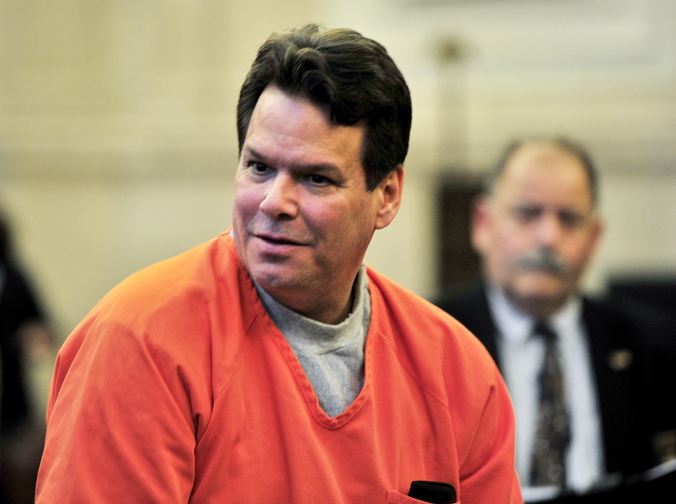The legal fate of Dennis Dechaine now rests, as it has for 25 years, in the hands of Superior Court Justice Carl Bradford.
Bradford, 80, retired in 1998 but is still an active judge and is called upon to preside over certain cases, including that of Dechaine, whom Bradford sent to prison for life in 1989.
On Thursday and Friday in a Portland courtroom, Bradford listened to testimony from DNA experts. He now awaits written arguments from the defense and prosecution before he determines whether Dechaine is granted a new trial.
Deputy Attorney General William Stokes will argue that Dechaine does not deserve a new trial. The state believes that he alone is responsible for the 1988 killing of 12-year-old Sarah Cherry and no amount of DNA analysis is going to change that.
Defense attorney Steven Peterson, who has handled Dechaine’s appeal since 2004, is hoping that the new DNA analysis presented over the last two years, including more this week, is enough to establish the smallest amount of doubt.
Dechaine, who spoke briefly to reporters after Friday’s hearing in Cumberland County Unified Court, seemed hopeful but not overly so.
“Judge Bradford, I think he made up his mind in 1988,” he said.
On July 6, 1988, Cherry was kidnapped from a home where she was babysitting.
Her body was found two days later in woods nearby in Bowdoin. She had been sexually assaulted with sticks, stabbed many times and strangled with a scarf.
Dechaine, then a 30-year-old farmer from Bowdoinham, became the sole suspect after significant circumstantial evidence pointed to him.
He stumbled out of the same woods where Cherry’s body was found. His truck was parked nearby. Rope from his truck had been used to bind the girl’s hands. A notebook and a truck repair bill with his name were found in the driveway of the home from which Cherry disappeared.
Dechaine also had a weak alibi. He told police that he spent the day doing drugs and wandering in the woods.
Still, no physical evidence was found on either Cherry or Dechaine linking the two.
Since the original conviction, Dechaine has amassed a mountain of support in Maine and beyond. A group called Trial and Error has raised money for his appeals and DNA testing. A national group called the Innocence Project, which has helped secure many new trials and exonerations for wrongfully convicted prisoners, also has backed Dechaine for many years.
The legal battle, now in its 25th year, is the longest criminal case in state history and is far from over.
Dechaine’s latest bid for a new trial hinges on whether DNA evidence obtained from one of Cherry’s fingernails and additional DNA taken from her shirt, bra and scarf point to someone other than Dechaine.
Testimony Thursday and Friday from DNA experts called by Peterson and Stokes did not appear to provide any more clarity on that matter.
Greg Hampikian, a professor of biology at Boise State University and a forensic DNA expert who worked on the Amanda Knox case, testified Friday that there were at least two separate male DNA profiles on a scarf and shirt that belonged to Cherry.
Dechaine could not be ruled out as a match for one of those DNA profiles, but neither could an alternative suspect named Douglas Senecal, whom Dechaine’s defense team has tried to implicate many times over the years.
Hampikian’s testimony backed up testimony given Thursday by Rick Staub, a Texas-based forensics DNA expert, who drew the same conclusions about multiple DNA profiles being found on the scarf and shirt.
The existence of multiple DNA profiles on Cherry’s scarf and shirt, coupled with the fact that DNA found underneath one of Cherry’s fingernails does not match Dechaine, appears to cast doubt, Peterson says.
Stokes’ questioning of Hampikian seemed to assert that any of the DNA found on Cherry’s fingernails or her clothes did not necessarily belong to her killer.
Stokes, and a subsequent witness for the prosecution, said the small amounts of DNA collected simply cannot lead to any conclusions.
Carl Ladd, director of the Connecticut Forensic Laboratory, also questioned the validity of the new DNA analysis.
Ladd testified Friday, as he did in 2012, that the conditions when Cherry’s nails were clipped were “textbook” for contamination.
Ladd also said that the additional testing conducted earlier this year by a Texas lab on Cherry’s shirt, bra and scarf had an “increased chance of contamination.”
Hampikian, however, said that if DNA analysis had been done back in 1988, it likely would have pointed to more than one potential suspect.
Dechaine was the only suspect ever investigated by police.
Peterson can present an alternative suspect theory only if the case gets a new trial, and that threshold is high.
A law passed in 2006 – largely because of the Dechaine case – says that in cases using DNA to push for a new trial, the new evidence needs to be so strong that it outweighs all other evidence.
Dechaine’s bid for a new trial has lasted five years so far and it could still be months before Bradford decides.
Peterson has said that even if Bradford does not grant a new trial, he’ll continue to appeal on Dechaine’s behalf.
The next step would be the Maine Supreme Judicial Court. After that, it could go to the federal appeals court in Boston.
Eric Russell can be contacted at 791-6344 or at: erussell@pressherald.com
Twitter: @PPHEricRussell
Send questions/comments to the editors.




Comments are no longer available on this story